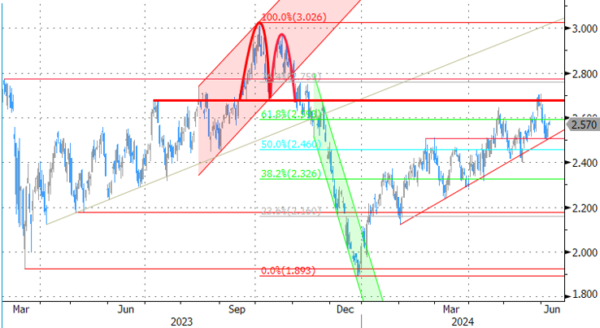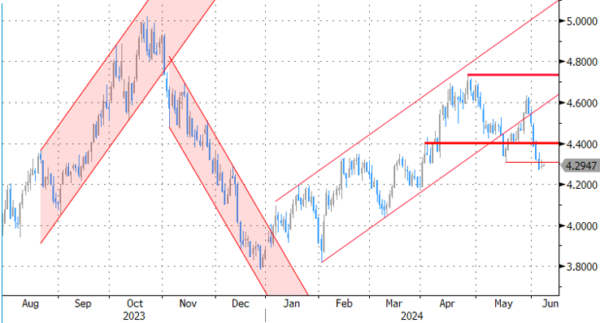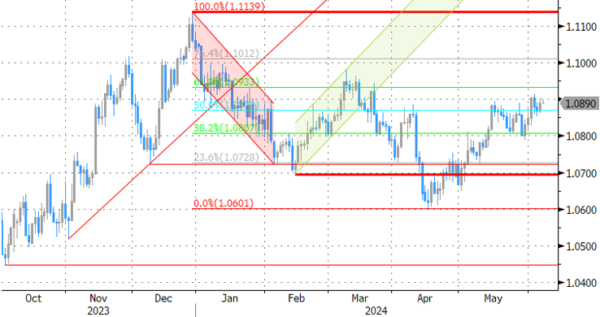Markets
German bunds underperformed US Treasuries in the wake of yesterday’s ECB policy meeting. Rates rose between 2.2 and 4.4 bps. The central bank cut rates by 25 bps for the first time in five years but still-high domestic price pressures and elevated wage growth mean it has to tread carefully down the easing path. Upwardly revised headline and core inflation forecasts (averaging >2% in 2025) showcase the point. President Lagarde (AKA the lady in charge) referred to the fact that real rates today were much higher than they were before with rates being steady since September but inflation having eased materially. This allowed for some removal of the current restrictiveness without pre-committing to anything nor declaring the central bank has now entered the “dialing back phase”. The hawkish cut meant that markets are no longer sure about a second move this year. Higher-than-expected weekly jobless claims clipped US rates’ cautious upward daily momentum. Yields eventually gained up to 1.2 bps (10-yr). EUR/USD appreciated and went for a test of the 1.09 big figure, supported by the generally positive (especially in Europe) risk environment. Unable to push through, the pair closed the day at 1.089. The trade-weighted dollar index moved south with the 104 barrier in focus.
Today’s US payrolls are important for both sides of the Atlantic in our view. The ECB’s data dependence should be seen broadly, with not only European data important for policy going forward, but also what the likes of the Fed (will) do. And the Fed’s sensitivity to the labour market is high. Consensus expects a job growth of 180k in May, more or less the pace of April. Wages are expected to grow 0.3% (3.9% y/y). US money markets in theory could add some more to a September Fed cut and raise the stakes for 2025 (currently 3.5 cuts) in case of an in line or slightly softer release. Yields at the front end of the US curve (2-yr) are close to support levels though, offering some protection to the downside. A break lower should only occur in case of a significant negative surprise. We also spot some bottoming out in longer maturities, including the 10-yr. Current ECB market pricing makes European rates vulnerable for a downleg in sympathy with the US. But to the extent it filters through to a positive risk (equity) environment, we are biased towards USD rather than euro weakness. EUR/USD continues to flirt with the 1.09 resistance zone and could get tested intensively. A break higher brings 1.0981 on the horizon. The usual slew of ECB speeches in the wake of the decision are worth following up.
News & Views
China foreign trade data for the month of May published this morning still indicated a mixed picture with respect to the country’s growth. Exports (in USD terms) jumped to 7.6% Y/Y indicating foreign demand to support the country’s economic. However, the figure was also supported by favourable base effects. At the same time, import growth slowed more than expected from 8.4%Y/Y in April to 1.4% in May, pointing to still mediocre domestic demand. The trade balance grew from $72.35 bln in April to $82.62 bln in May. Still the data over April and May combined suggest that net exports might provide a positive contribution to the country’s growth in Q2. In the meantime, the yuan hovers within reach of the year-to-date weakest levels near USD/CNY 7.245.
The Reserve Bank of India today kept its policy rate unchanged at 6.50% for the eight straight meeting in 4-2 vote as two members supported a rate cut. The bank kept its inflation forecast of FY 2025 unchanged at 4.5%, but raised its growth forecast from 7.0% to 7.2%. The Bank kept a guarded stance as of withdrawal of accommodation. At least of now, the RBI doesn’t show any intention to move to a more growth supportive policy stance as keeps the focus on bringing inflation back to the 4% target. In this respect, governor Das still warned that uncertainty with respect to food prices still needs close monitoring. The Indian rupee trades little changed near USD/IN 83.45.
Graphs
GE 10y yield
The ECB cut rates in June by 25 bps. But still-high domestic price pressures, elevated wage growth and upgraded inflation forecasts means the central bank cannot pre-commit to anything. Data-dependence remains the buzzword. The German 10y yield bounced off on the upward sloping trendline after a US correction pulled it lower. The backdrop of a recovering European economy should protects its downside.
US 10y yield
The Fed in May acknowledged the lack of progress towards the 2% inflation objective, but Fed Chair Powell indicated that further tightening was unlikely. However, the FOMC Minutes still showed internal debate on whether policy is restrictive enough. Sticky inflation suggests any rate cut will be a tough balancing act while several policy makers hint at a higher neutral rate. The US 10-y yield is correcting lower in the 4.3/4.7% trading range.
EUR/USD
Economic divergence, a likely desynchronized rate cut cycle with the ECB exceptionally taking the lead and higher than expected US CPI data pushed EUR/USD to the 1.06 area. From there, better EMU data gave the euro some breathing space. The dollar lost further momentum on softer than expected early May US data. Some further consolidation in the 1.06/1.09 area might be on the cards short-term.
EUR/GBP
Debate at the Bank of England is focused at the timing of rate cuts. Slower than expected April disinflation and a surprise general election on July 4 suggest that a June cut in line with the ECB looks improbable. Sterling gained momentum with money markets now discounting a Fed-like scenario. EUR/GBP tested the 2023 & 2024 lows near 0.85. We expect this important support level to hold.
















